Templo Haeinsa en Hapcheon (해인사(합천))
11.8Km 2025-06-27
Haeinsa-gil 122, Gaya-myeon, Hapcheon-gun, Gyeongsangnam-do.
El templo Haeinsa fue fundado durante el tercer año del reinado de Ae-Jang, año 802 de nuestra era, por dos monjes budistas llamados Suneung e Ijeong. El nombre “Haein” originalmente proviene de la expresión Haeinsammae en Hwaeomgyeong (Escritos Budistas), cuyo significado es el mundo verdaderamente iluminado por Buda y la pureza natural de nuestro corazón.
Junto con la Tripitaka Koreana (Tesoro Nacional) y Janggyeongpanjeon (Tesoro Nacional), se conservan más de 15 tesoros públicos y unos 200 tesoros privados en el templo Haeinsa, que ha sido designado Patrimonio Cultural de la Humanidad en diciembre de 1995 por los numerosas propiedades culturales e históricas que se preservan en él. Iljumun, Daejeokgwangjeon y la Tripitaka Koreana están reconocidos como tesoros de Corea.
La Puerta Iljumun era la primera entrada que todo sattva debía pasar para convertirse en Buda y era considerada una obra representativa de la arquitectura antigua coreana. Daejeokgwangjeon, el gran santuario, y la pagoda de piedra tres niveles en el jardín poseen la majestuosa elegancia de un templo de mil años de antigüedad.
El proceso de la elaboración de la Tripitaka Koreana, el tesoro más famoso del templo Haeinsa, comenzó en el 23er. año de la dinastía Goryeo (año 1236 de nuestra era) y demoró 16 años en ser acabada. Su elaboración se realizó para exteriorizar el deseo de superar la crisis nacional causada por la invasión mongola. Las dimensiones de las tablas de impresión hechas en madera son: 68 cm de ancho, 2,5 cm de largo y 3 cm de grosor. A cada lado se colocó una varilla de madera para mantener el balance y se cubrió con laca para protegerlas de la corrosión. Toda la madera utilizada en la elaboración de estas tablas fue tomada de los árboles de magnolia asiática o magnolia plateada que crecen en la región del Mar del Sur y de Geoje. Dichas maderas fueron cortadas, sumergidas en el agua salina del mar durante varios años y luego escurridas y desecadas a la sombra para finalmente hacerles las inscripciones, dando origen a las tablas de impresión. Estos bloques nacieron como resultado del esfuerzo del rey y de su pueblo para rechazar a los mongoles con el apoyo de Buda. El número de las tablas es de 81.340 y se clasifican en 6.791 volúmenes.
Parque Nacional del Monte Gayasan (Sector de Baegun-dong) (가야산국립공원(백운동 지구))
12.1Km 2023-02-20
Baegun-ri, Suryun-myeon, Seongju-gun, Gyeongsangbuk-do
El monte Gayasan, en Gyeongsangbuk-do, fue designado como Parque Nacional en 1972. La cima Chilbulbong llega a los 1.433 metros. Hace límite con Seongju-gun, Hapcheon-gun y Geochang-gu. En particular, Suryun-myeon, en Seongju-gun, es famoso por su paisaje. Además, la belleza de la montaña, que se extiende desde Suryun-myeon hasta la montaña, destaca el esplendor y la grandeza de los acantilados escarpados de color carmesí. El recorrido también ofrece una vistas hermosas durante todo el tramo de senderos hasta llegar a las fascinantes cascadas.
En la zona Baegun-dong, se encontrará con el templo Beopjusa. Este templo fue construido durante el período de Silla y se dice que fue el mayor templo de su tiempo, con aproximadamente 100 recintos. Ahora, solo permanecen una estupa, pilares y soportes. El valle Yonggigol ofrece unos caminos donde poder disfrutar de las impresionantes vistas del monte Gayasan.
Jardín Botánico de Plantas Silvestres de Gayasan (가야산 야생화식물원)
12.4Km 2022-08-03
Gayasansingmurwon-gil 49, Suryun-myeon, Seongju-gun, Gyeongsangbuk-do.
Establecido en junio de 2006, el Jardín Botánico de Plantas Silvestres de Gayasan es el primer jardín de plantas silvestres del país, con aproximadamente 400 especies distintas. El jardín exterior ofrece un magnífico paisaje del monte Gayasan, y tiene diferentes sectores: arbustos, jardín de crisantemos, jardín de plantas nativas de Gayasan, jardín educativo de plantas silvestres, etc. Por su parte, el invernadero está formado por árboles de temperaturas cálidas y plantas silvestres. Disfrute de la agradable fragancia de las flores durante todas las estaciones del año.
Gaya Hotel (가야호텔)
12.4Km 2025-01-02
52, Gayasansingmurwon-gil, Seongju-gun, Gyeongsangbuk-do
+82-54-931-3500
Gaya Hotel is located 560 meters above sea level on Gayasan Mountain in a pristine natural environment. The hotel also offers a sauna that uses natural mineral water. Near the hotel is the only Korean wild flower botanical garden.
Túmulos de Jisan-dong en Goryeong (고령 지산동 고분군)
13.8Km 2022-09-19
Daegaya-eup, Goryeong-gun, Gyeongsangbuk-do.
Goryeong, capital del reino de Daegaya que tomó el poder tras la caída de Geumgwangaya, entre los 6 reinos de Gaya, prácticamente es un museo al aire libre. Sobre la cresta del sudeste del monte Jusan se hallan 200 túmulos de Daegaya. Sobre esta cresta se encuentra el túmulo que mide 20 m de diámetro, otros medianos están en el centro de Daegaya-eup y los pequeños al pie de la montaña. El túmulo más grande del sur se llama Geumnimwangneung.
Desde 1977, se realizó activamente la excavación tras el descubrimiento de los túmulos por la Universidad Gyeongbuk y Universidad Gyemyeong, lo cual ayudó en gran medida las investigaciones sobre Daegaya. Encontraron grandes cantidades de coronas de oro, accesorios de oro, plata y jade, armaduras, etc. Sobre todo, en el túmulo nº 42 se hallaron 32 salas secundarias alrededor de la sala principal para el entierro de vivos con el muerto, lo cual hizo comprobar el sistema de este tipo de entierro. Hay un museo que se llama el Museo de Túmulos Reales de Daegaya, construido para dar a conocer características de tumbas con el entierro de vivos con el muerto y la estructura social de ese período.
Museo de Daegaya (대가야 박물관)
14.0Km 2022-09-13
Daegaya-ro 1203, Daegaya-eup, Goryeong-gun, Gyeongsangbuk-do.
Es un centro de exposición integral, en donde los visitantes podrán conocer la historia y la cultura completa de la época de Daegaya, participando en los diferentes tipos de programas. También podrán experimentar sus costumbres y tradiciones folclóricas. Exhibe y conserva aproximadamente 300 reliquias excavadas en el área histórica de Jisan-dong, del distrito de Gobun-gun, declarado Sitio Histórico, y los encontrados en la zona de Goryeong.
Los patrimonios descubiertos se representan con los mismos formatos que en la antigüedad, y en particular el pabellón con el techo con forma de bóveda, en dimensión y estructura, es el mejor del país. El museo también cuenta con instalaciones anexas de última tecnología, materiales audiovisuales, sector de búsqueda de información, túnel de imágenes, etc. Recorriendo el museo, podrá apreciar la espléndida cultura del hierro y el barro correspondiente a aquella época y descubrirá que esto ha influenciado a algunas épocas antiguas de Japón.
Complejo Temático de la Historia de Daegaya (대가야 역사테마관광지)
14.2Km 2021-12-10
Daegaya-ro 1216, Daegaya-eup, Goryeong-gun, Gyeongsangbuk-do
+82-54-950-7005
Este es un parque temático que enseña sobre la cultura y la historia de la cultura del antiguo reino de Daegaya, utilizando tecnología de punta. Además, hay espacios verdes que ofrecen un rico descanso a los visitantes.
Festival de Daegaya en Goryeong (고령대가야축제)
14.2Km 2025-03-27
Daegaya-ro 1216, Goryeong-gun, Gyeongsangbuk-do
054-950-6427
* La edición 2025 del festival se ha cancelado debido a incendios forestales en la región.
Parque Nacional del Monte Gayasan (Áreas de Hongnyu-dong y Cheongnyang-dong) (가야산국립공원(홍류동,청량동지구))
14.3Km 2021-04-27
Gayasan-ro 1200, Gaya-myeon, Hapcheon-gun, Gyeongsangnam-do.
+82-55-930-8000
Con el pico más alto, Sangwangbong, como eje central, el monte Gayasan se compone de muchos picos con alturas superiores a los 1.000 m, conectados unos a otros como una pintura en pergamino. Este parque tiene ocho de los paisajes más bellos para la gente del período de Joseon.
En 1972, el monte fue designad como parque nacional, debido a sus bellas características. En el monte Gayasan hay numerosos puntos turísticos de alta fama. En especial, el templo Haeinsa, que se sitúa en el sector sudoeste del monte Gayasan, es uno de los templos más famosos de toda Corea. En este templo se halla la Tripitaka Koreana (Tesoro Nacional Nro. 32), que consiste en más de ochenta mil bloques de madera donde se encuentran inscriptas las enseñanzas del budismo. Este lugar logra una fantástica escena con el antiguo templo y el bello paisaje del entorno. Además, en él se conservan otros patrimonios culturales tales como Janggyeonggak (Tesoro Nacional Nro. 52), Figura de Piedra del Buda (Tesoro Nro. 518), el Monumento del Templo Banya Gyeongwangsa (Tesoro Nro.128) que fueron designados Patrimonio Cultural de la Humanidad por la Unesco.
Asimismo, el monte Gayasan es famoso por las líneas armoniosas y llenas de gracia que trazan las figuras de sus picos. El agua que fluye desde el valle de Gayasan llega al templo Haeinsa y cambia su curso hacia el sudeste, donde se forman el arroyo Gayacheon. Entre los numerosos valles, el valle Hongnyudong (cuyas aguas parecen teñidas de color carmesí, porque reflejan los tonos rojizos de las hojas otoñales) le da el toque final a su grandioso panorama junto al grupo de pinos añejos de más de mil años. Namsanjeilbong, un pico situado en la parte sur de Hongnyu-dong, recibe el nombre de monte Cheonbulsan entre los budistas porque su cresta parece estar cubierta de miles de estatuas de Buda. El monte Cheonbulsan es una de las rutas favoritas de una jornada para muchos que practican el montañismo.
El monte Gayasan muestra vistas magníficas en cada estación del año, con las flores de cerezo, azaleas y azaleas reales que se alinean sobre uno lado del sendero al templo Haeinsa en primavera, las claras aguas y verdes árboles en verano, los gloriosos tintes del follaje otoñal que se extienden a lo lardo de las crestas rocosas en otoño y un paisaje blanco por la nieve en invierno.
Templo Yeonhosa (연호사)
16.0Km 2021-03-03
Jukjuk-gil 80, Hapcheon-eup, Hapcheon-gun, Gyeongsangnam-do
+82-55-931-2508
El templo Yeonhosa se ubica en Gyeongsangnam-do y por detrás se visualiza el majestuoso monte Hwangusan. Las leyendas locales cuentan que este recinto budista fue construido para consolar el espíritu de los soldados caídos del reino de Silla.
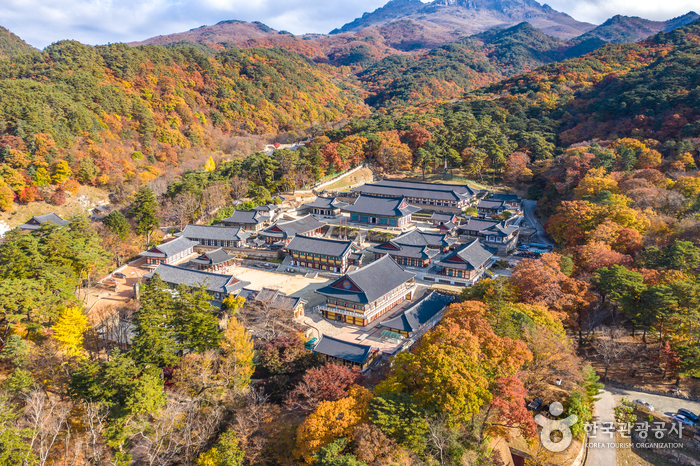

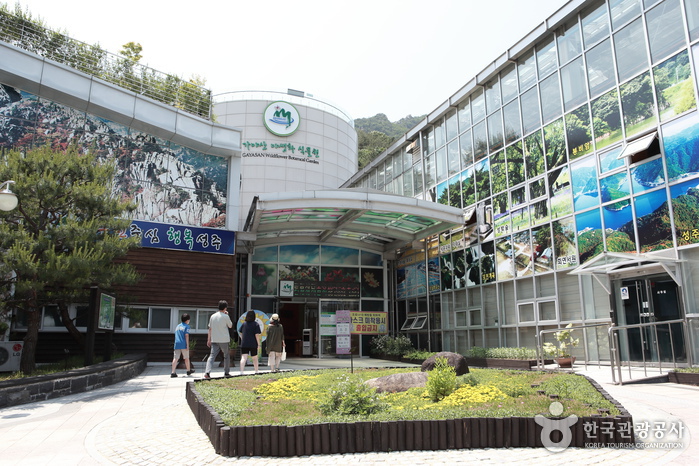
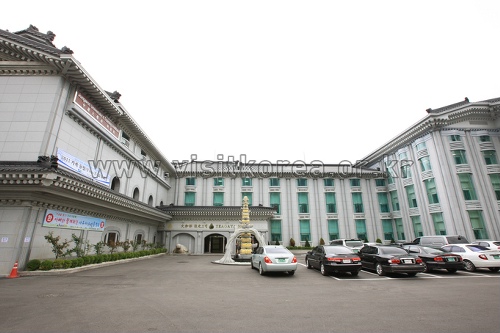
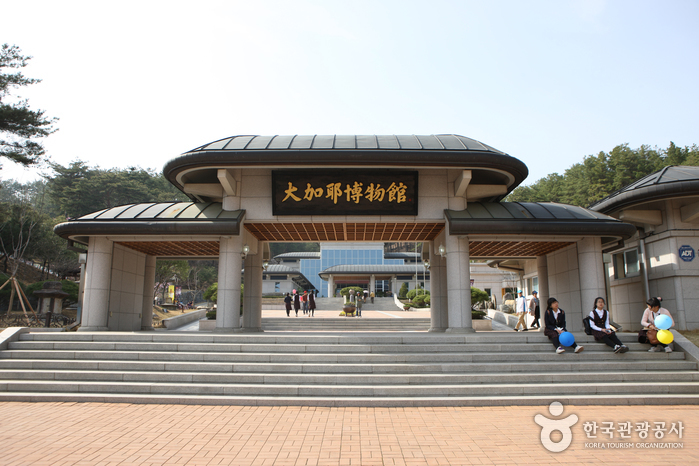
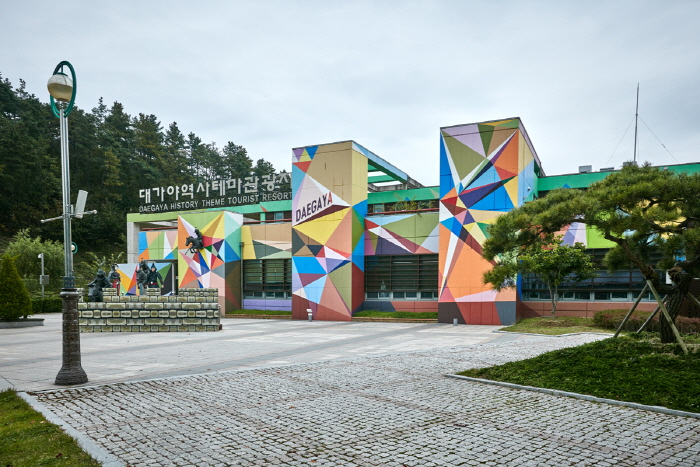

 Español
Español
 한국어
한국어 English
English 日本語
日本語 中文(简体)
中文(简体) Deutsch
Deutsch Français
Français Русский
Русский